Photooxidative Dehydrogenation of Chiral Ir (III) Amino Acid Complexes Based on [Λ-Ir(ppy)2(MeCN)2](PF6)
Abstract
:1. Introduction
2. Results and Discussion
2.1. Synthesis of Amino Acid Complexes and Photooxidative Dehydrogenation Reaction
2.2. Characterization of Crystal Structures
3. Materials and Methods
3.1. Synthesis of Chiral Amino Acid Complexes Λ-[Ir(ppy)2(L/D-AA)]
3.2. Synthesis of Chiral Imino Acid Complexes Λ-[Ir(ppy)2(AA-2H)]
3.3. Kinetic Study of Photooxidative Dehydrogenation Reaction
3.4. Crystal Structure of Complexes
4. Conclusions
Supplementary Materials
Author Contributions
Funding
Data Availability Statement
Conflicts of Interest
References
- Turner, N.J. Enantioselective Oxidation of C-O and C-N Bonds Using Oxidases. Chem. Rev. 2011, 111, 4073–4087. [Google Scholar] [CrossRef] [PubMed]
- Beatty, J.W.; Stephenson, C.R.J. Amine Functionalization via Oxidative Photoredox Catalysis: Methodology Development and Complex Molecule Synthesis. Acc. Chem. Res. 2015, 48, 1474–1484. [Google Scholar] [CrossRef] [PubMed]
- Zou, Y.-Q.; Hörmann, F.M.; Bach, T. Iminium and enamine catalysis in enantioselective photochemical reactions. Chem. Soc. Rev. 2018, 47, 278–290. [Google Scholar] [CrossRef] [PubMed]
- Abdine, R.A.A.; Hedouin, G.; Colobert, F.; Wencel-Delord, J. Metal-Catalyzed Asymmetric Hydrogenation of C=N Bonds. ACS Catal. 2021, 11, 215–247. [Google Scholar] [CrossRef]
- Mikami, K.; Yajima, T.; Kaneko, M. Asymmetric Imine-Ene Reactions: Diastereofacial Selective Reactions with Chiral Glyoxylate Derived α-Imino Esters and Asymmetric Catalysis of Enantiofacial Selective Reactions with Prochiral α-Imino Esters. Amino Acids 1998, 14, 311–318. [Google Scholar] [CrossRef] [PubMed]
- Mikami, K.; Kaneko, M.; Yajima, T. Asymmetric Imine-Ene Reactions with Chiral Glyoxylate-Derived α-Imino Esters: An Efficient Route to Asymmetric Synthesis of α-Amino Acids. Tetrahedron Lett. 1993, 34, 4841–4842. [Google Scholar] [CrossRef]
- Leitch, J.A.; Rossolini, T.; Rogova, T.; Maitland, J.A.P.; Dixon, D.J. α-Amino Radicals via Photocatalytic Single-Electron Reduction of Imine Derivatives. ACS Catal. 2020, 10, 2009–2025. [Google Scholar] [CrossRef]
- Dang, Y.; Wang, Y.; Li, Y.; Xu, M.; Jia, C.; Lu, Y.; Zhang, L.; Li, Y.; Xia, Y. Nucleophilic Addition and α-C-H Substitution Reactions of an Imine Mediated by Dibutylmagnesium and Organolithium Reagents. Organometallics 2021, 40, 1830–1837. [Google Scholar] [CrossRef]
- Leng, L.; Fu, Y.; Liu, P.; Ready, J.M. Regioselective, Photocatalytic α- Functionalization of Amines. J. Am. Chem. Soc. 2020, 142, 11972–11977. [Google Scholar] [CrossRef]
- Kobayashi, S.; Mori, Y.; Fossey, J.S.; Salter, M.M. Catalytic Enantioselective Formation of C-C Bonds by Addition to Imines and Hydrazones: A Ten-Year Update. Chem. Rev. 2011, 111, 2626–2704. [Google Scholar] [CrossRef]
- Chen, B.; Wang, L.; Gao, S. Recent Advances in Aerobic Oxidation of Alcohols and Amines to Imines. ACS Catal. 2015, 5, 5851–5876. [Google Scholar] [CrossRef]
- Keene, F.R. Metal-ion promotion of the oxidative dehydrogenation of coordinated amines and alcohols. Coord. Chem. Rev. 1999, 187, 121–149. [Google Scholar] [CrossRef]
- Goto, M.; Koga, N.; Ohse, Y.; Kudoh, Y.; Kukihara, M.; Okuno, Y.; Hiromasa Kurosaki, H. Selective Dehydrogenation of Amines with Respect to Coordination Geometry: Different Oxidation Products of Tricyano[bis(2-pyridylmethyl)amine]ferrate(II) between mer- and fac-Isomers. Inorg. Chem. 2004, 43, 5120–5127. [Google Scholar] [CrossRef]
- Tamura, M.; Tsuge, K.; Igashira-Kamiyama, A.; Konno, T. A bisbipyridine osmium(II) complex with an N,S-chelating 2-aminoethanesulfinate: Photoinduced conversion of an amine to an imine. Chem. Commun. 2011, 47, 12464–12466. [Google Scholar] [CrossRef] [PubMed]
- Saucedo-Vázquez, J.P.; Ugalde-Saldívar, V.M.; Toscano, A.R.; Kroneck, P.M.H.; Sosa-Torres, M.E. On the Mechanism of Iron(III)-Dependent Oxidative Dehydrogenation of Amines. Inorg. Chem. 2009, 48, 1214–1222. [Google Scholar] [CrossRef]
- Bendahl, L.; Hammershøi, A.; Jensen, D.K.; Larsen, S.; Riisager, A.; Sargeson, A.M.; Sørensen, H.O. Metal complex amino acid synthons: Syntheses, structures and stereoselective reactions of (iminoacetato)cobalt(III) complexes. Dalton Trans. 2002, 15, 3054–3064. [Google Scholar] [CrossRef]
- Anjana, S.; Donring, S.; Sanjib, P.; Varghese, B.; Murthy, N.N. Controlling the oxidation of bis-tridentate cobalt(II) complexes having bis(2-pyridylalkyl)- amines: Ligand vs. metal oxidation. Dalton Trans. 2017, 46, 10830–10836. [Google Scholar] [CrossRef]
- Yamaguchi, M.; Saburi, M.; Yoshikawa, S. Novel Oxidative Dehydrogenation Reaction of α-Amino Acids Chelated to Cobalt(III)Ion: Synthesis of (2-1minocarboxylato)cobalt(III) Complexes. J. Am.Chem. Soc. 1984, 106, 8293–8295. [Google Scholar] [CrossRef]
- Yamaguchi, M.; Yamagishi, T. Facile Dehydrogenation of α-Amino Acids Chelated to a Bis(bipyridine)ruthenium(II) Complex:(α-Imino acidato)Ruthenium(II) Complexes. Inorg. Chem. 1993, 32, 2981–2982. [Google Scholar] [CrossRef]
- Yamaguchi, M.; Machiguchi, K.; Mori, T.; Kikuchi, K.; Ikemoto, I.; Yamagishi, T. Facile Dehydrogenation of α-Amino Acids Chelated to a Ruthenium(II) Ion: (α-Imino acidato)ruthenium-(II) Complexes. Inorg. Chem. 1996, 35, 143–148. [Google Scholar] [CrossRef]
- Cuello-Garibo, J.-A.; Perez-Gallent, E.; van der Boon, L.; Siegler, M.A.; Bonnet, S. Influence of the Steric Bulk and Solvent on the Photoreactivity of Ruthenium Polypyridyl Complexes Coordinated to L-Proline. Inorg. Chem. 2017, 56, 4818–4828. [Google Scholar] [CrossRef] [PubMed]
- Prier, C.K.; Rankic, D.A.; MacMillan, D.W.C. Visible Light Photoredox Catalysis with Transition Metal Complexes: Applications in Organic Synthesis. Chem. Rev. 2013, 113, 5322–5363. [Google Scholar] [CrossRef]
- Shaw, M.H.; Twilton, J.; MacMillan, D.W.C. Photoredox Catalysis in Organic Chemistry. J. Org. Chem. 2016, 81, 6898–6926. [Google Scholar] [CrossRef] [PubMed]
- Gong, L.; Chen, L.-A.; Meggers, E. Asymmetric Catalysis Mediated by the Ligand Sphere of Octahedral Chiral-At-Metal Complexes. Angew. Chem. Int. Ed. 2014, 53, 10868–10874. [Google Scholar] [CrossRef]
- Zhang, L.; Meggers, E. Steering Asymmetric Lewis Acid Catalysis Exclusively with Octahedral Metal-Centered Chirality. Acc. Chem. Res. 2017, 50, 320–330. [Google Scholar] [CrossRef] [PubMed]
- Ma, J.; Ding, X.; Hu, Y.; Huang, Y.; Gong, L.; Meggers, E. Metal-Templated Chiral Brønsted Base Organocatalysis. Nat. Commun. 2014, 5, 5531. [Google Scholar] [CrossRef]
- Meggers, E. Exploiting Octahedral Stereocenters: From Enzyme Inhibition to Asymmetric Photoredox Catalysis. Angew. Chem. Int. Ed. 2017, 56, 5668–5675. [Google Scholar] [CrossRef]
- Huo, H.; Shen, X.; Wang, C.; Zhang, L.; Röse, P.; Chen, L.-A.; Harms, K.; Marsch, M.; Hilt, G.; Meggers, E. Visible Light Activated Asymmetric Photoredox Transition Metal Catalysis. Nature 2014, 515, 100–103. [Google Scholar] [CrossRef]
- Huo, H.; Meggersa, E. Cooperative Photoredox and Asymmetric Catalysis. CHIMIA Int. J. Chem. 2016, 70, 186–191. [Google Scholar] [CrossRef]
- Ma, J.; Zhang, X.; Huang, X.; Luo, S.; Meggers, E. Preparation of chiral-at-metal catalysts and their use in asymmetric photoredox chemistry. Nat. Protoc. 2018, 13, 605–632. [Google Scholar] [CrossRef]
- Huang, X.; Meggers, E. Asymmetric Photocatalysis with Bis-Cyclometalated Rhodium Complexes. Acc. Chem. Res. 2019, 52, 833–847. [Google Scholar] [CrossRef] [PubMed]
- Yao, S.Y.; Chen, X.Y.; Ou, Y.L.; Ye, B.-H. Chiral Recognition and Dynamic Thermodynamic Resolution of Sulfoxides by Chiral Iridium(III) Complexes. Inorg. Chem. 2017, 56, 878–885. [Google Scholar] [CrossRef] [PubMed]
- Li, L.P.; Peng, H.L.; Wei, L.Q.; Ye, B.H. Diastereoselective photooxidation and reduction of chiral iridium (III) complexes. Inorg. Chem. 2019, 58, 785–793. [Google Scholar] [CrossRef]
- Xiong, M.F.; Ye, B.H. Regioselective Dehydrogenation of the Secondary Amine Complexes into Imine Complexes under Visible-Light Irradiation. Organometallics 2022, 41, 617–626. [Google Scholar] [CrossRef]
- Xiong, M.F.; Zhou, H.Y.; Huang, X.K.; Fan, J.Y.; Ye, B.H. Chiral Recognition and Photoreaction of β-Amino Acids with Iridium (III) Complexes. Chin. J. Chem. 2022, 40, 2909–2918. [Google Scholar] [CrossRef]
- Peng, H.L.; Li, Y.; Chen, X.Y.; Li, L.P.; Ke, Z.; Ye, B.H. Visible-light-induced amination of quinoline at the C8 position via a postcoordinated interligand-coupling strategy under mild conditions. Inorg. Chem. 2021, 60, 908–918. [Google Scholar] [CrossRef]
- Yao, S.Y.; Ou, Y.L.; Ye, B.H. Asymmetric synthesis of enantiomerically pure mono-and binuclear bis (cyclometalated) iridium (III) complexes. Inorg. Chem. 2016, 55, 6018–6026. [Google Scholar] [CrossRef]
- Sheldrick, G.M. Phase annealing in SHELX-90: Direct methods for larger structures. Acta Crystallogr. Sect. A 1990, 46, 467–473. [Google Scholar] [CrossRef]
- Sheldrick, G.M. Crystal structure refinement with SHELXL. Acta Crystallogr. Sect. C 2015, 71, 3–8. [Google Scholar] [CrossRef]
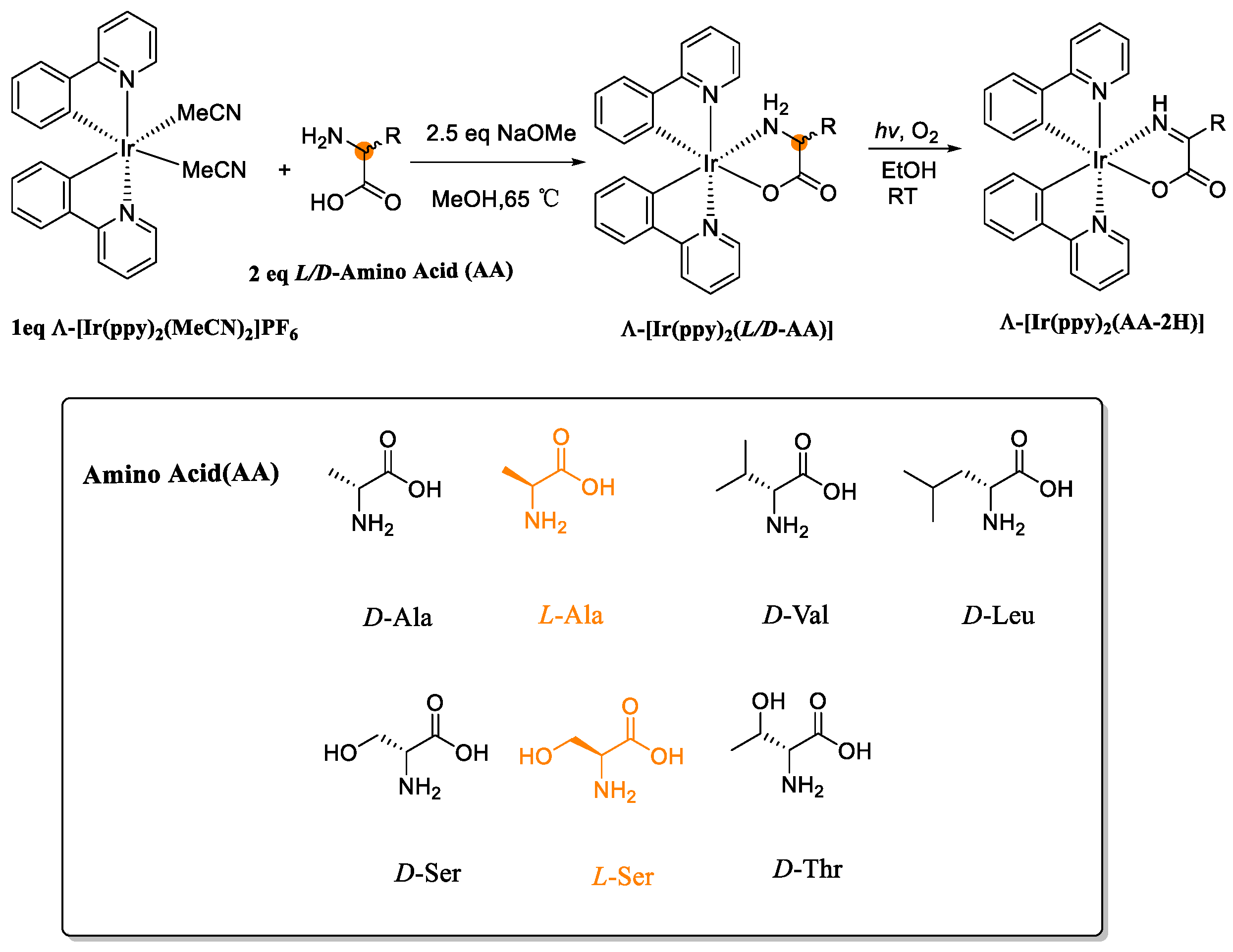
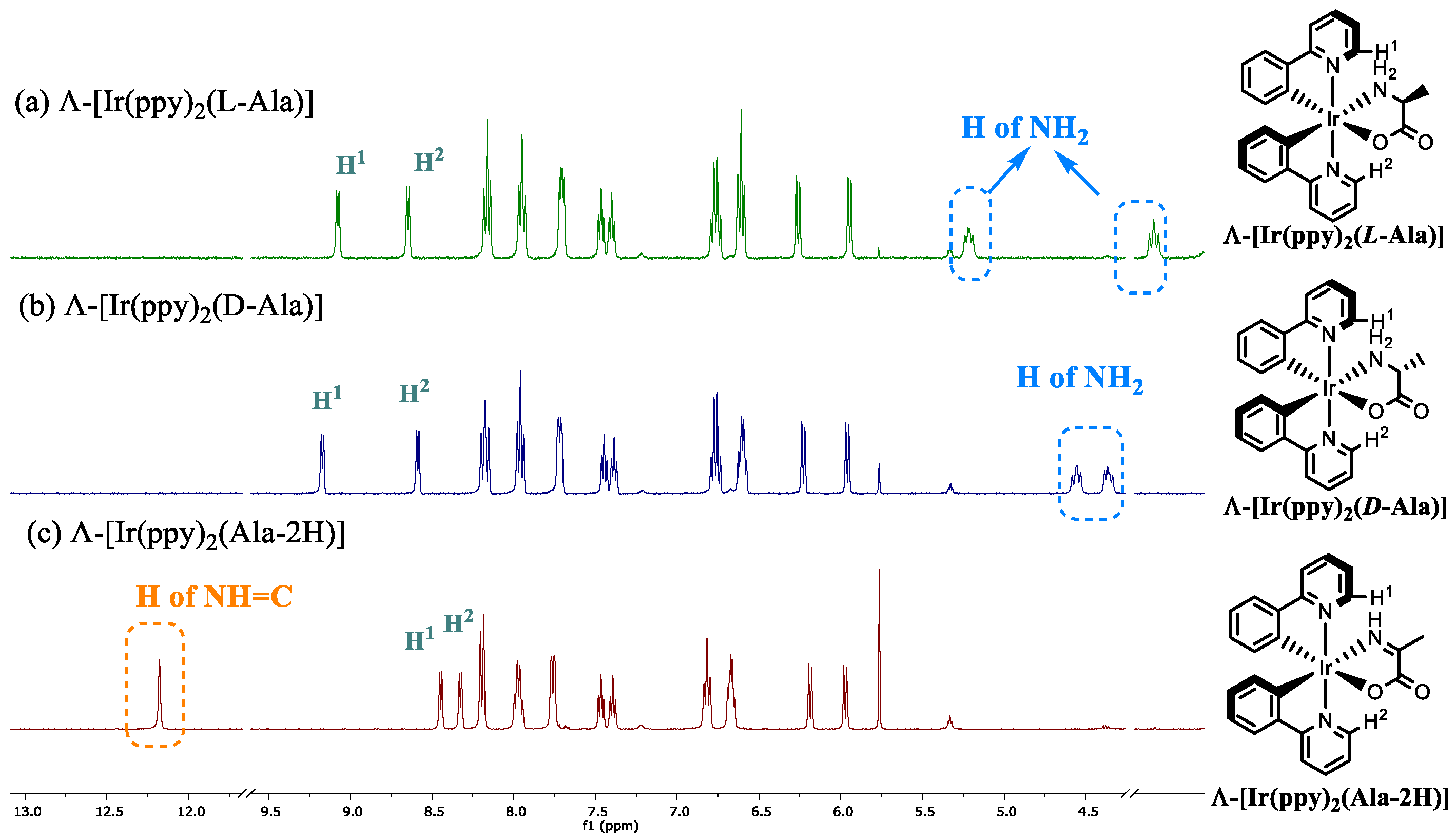

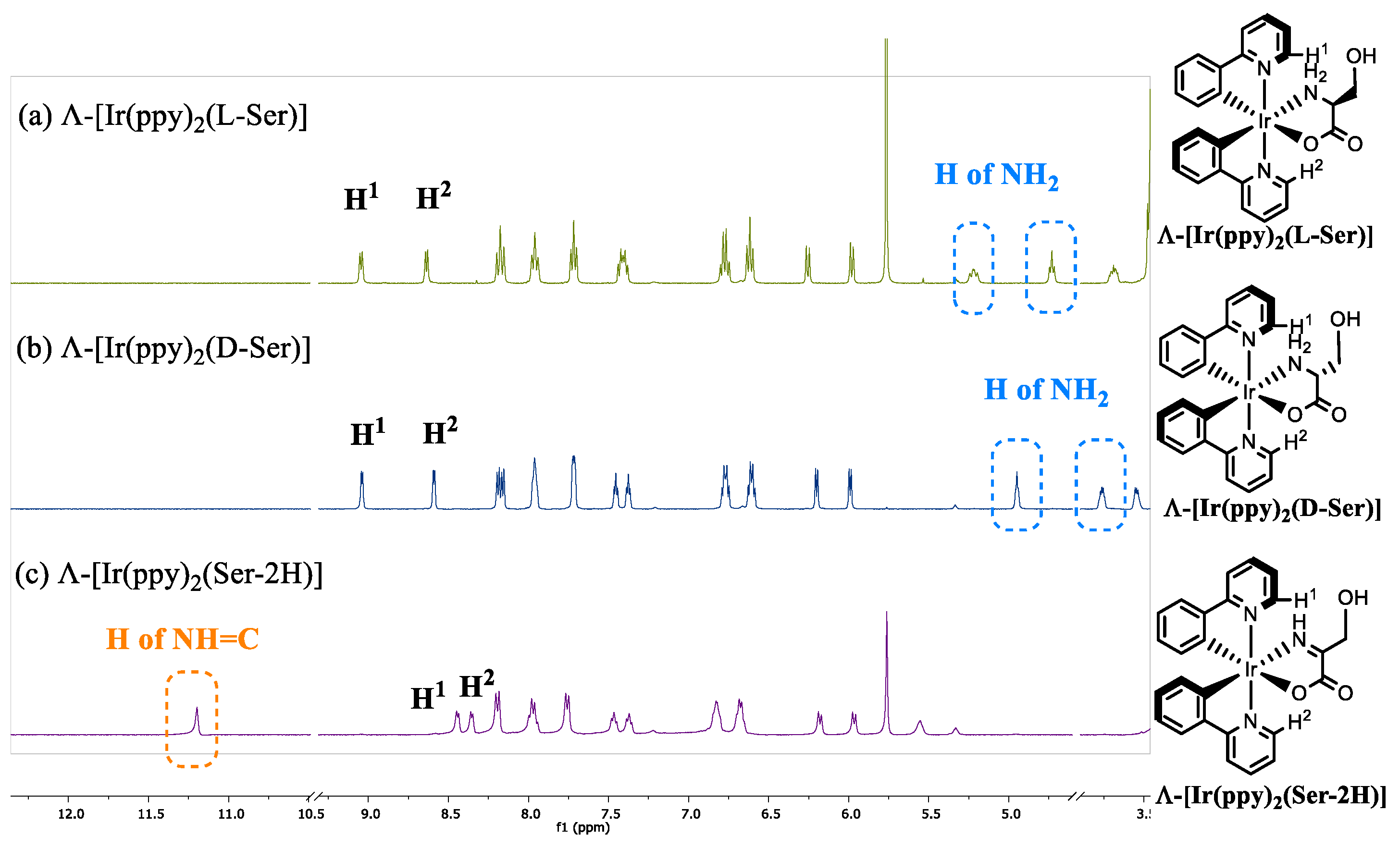
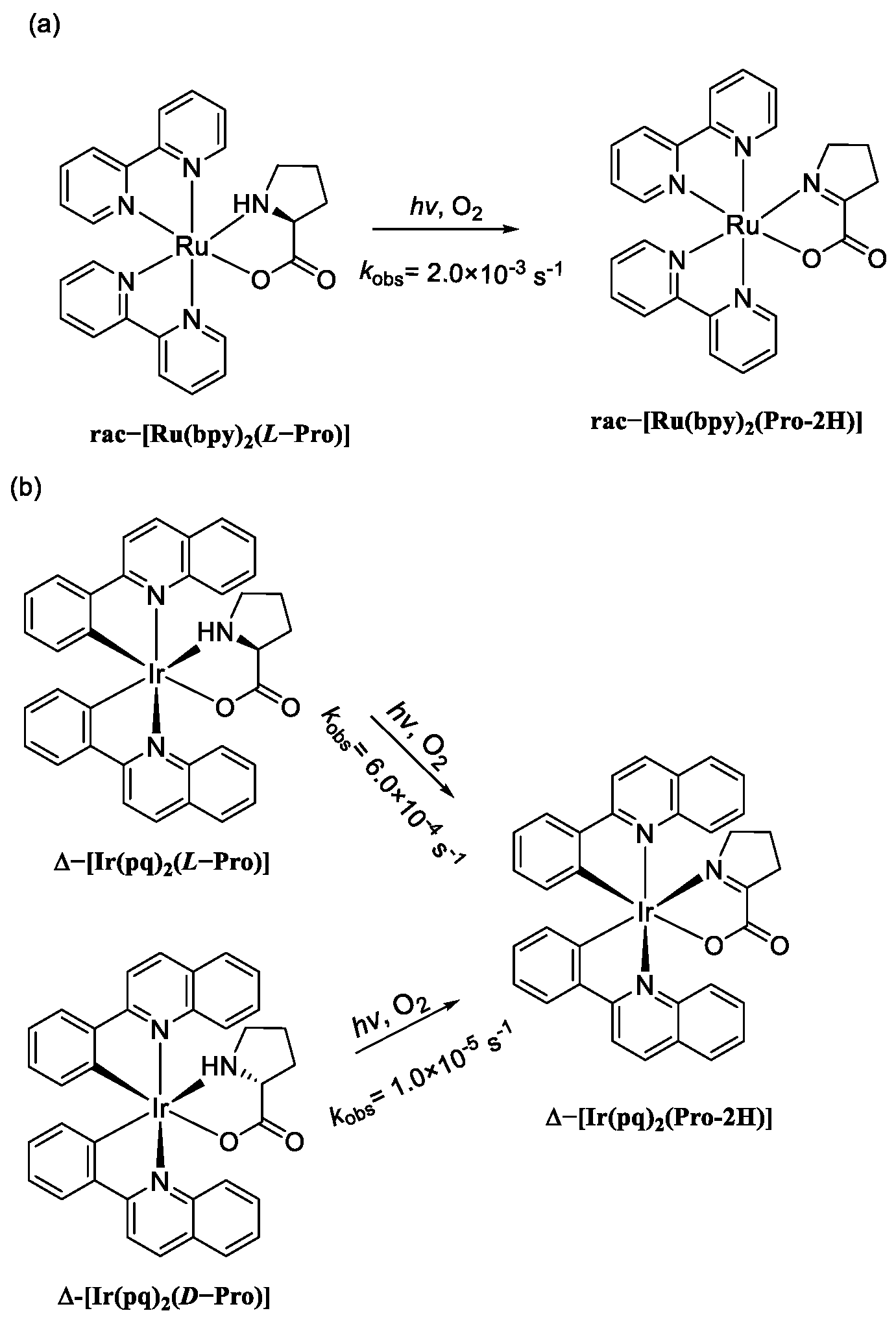
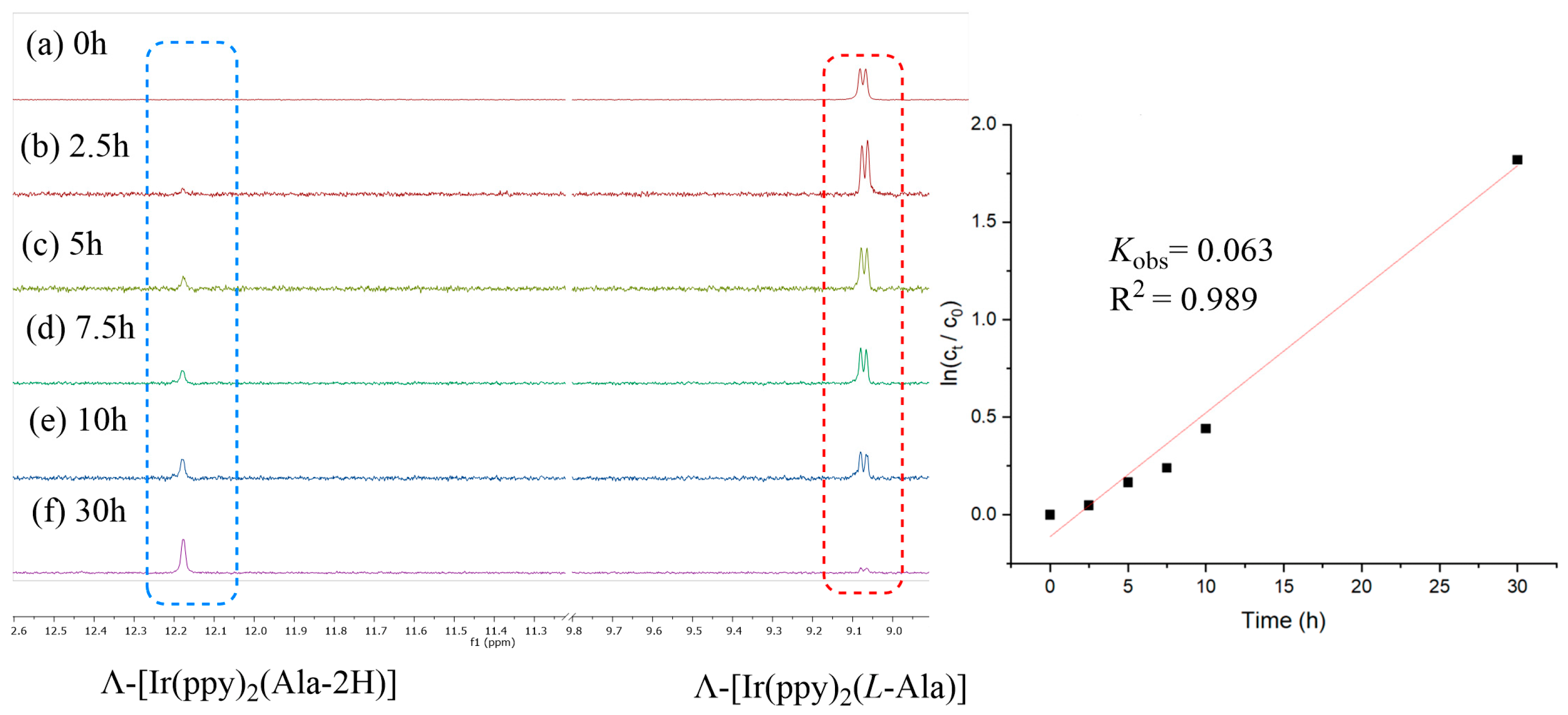


| Amino Acid | Yield a (%) | Kobs (h −1) |
|---|---|---|
| D-Ala | 97 | 0.205 |
| L-Ala | 96 | 0.063 |
| D- Ser | 93 | 0.111 |
| L-Ser | 93 | 0.074 |
| D-Val | 97 | 0.179 |
| D-Leu | 94 | 0.169 |
| D-Thr | 95 | 0.192 |
| Complex | Λ-[Ir(ppy)2(D-Thr)]·CH3OH (1) | Λ-[Ir(ppy)2(Thr-2H)] (2) |
|---|---|---|
| Empirical formula | C27H28IrN3O4 | C26H22IrN3O3 |
| Formula weight | 650.72 | 616.66 |
| Temperature | 293(2) K | 293(2) K |
| Wavelength | 1.54184 Å | 1.54184 Å |
| Crystal system, space group | Orthorhombic, P212121 | Orthorhombic, P212121 |
| Unit cell dimensions | a = 10.3001(1) Å, α = 90° | a = 9.3943(1) Å, α = 90° |
| b = 10.5102(1) Å, β = 90° | b = 11.1574(1) Å, β = 90° | |
| c = 23.0301(1) Å, γ = 90° | c = 22.1602(2)Å, γ = 90° | |
| Volume | 2493.15(4) Å3 | 2322.73(4) Å3 |
| Z, calculated density | 4, 1.734 Mg/m3 | 4, 1.763 Mg/m3 |
| Absorption coefficient | 10.682 mm−1 | 11.397 mm−1 |
| F(000) | 1280 | 1200 |
| Crystal size | 0.210 × 0.190 × 0.180 mm | 0.240 × 0.220 × 0.160 mm |
| Theta range for data collection | 3.839 to 76.808 deg. | 3.990 to 76.773 deg. |
| Limiting indices | −9 ≤ h ≤ 12, −12 ≤ k ≤ 13, −28 ≤ l ≤ 28 | −11 ≤ h ≤ 10, −13 ≤ k ≤ 8, −27 ≤ l ≤ 27 |
| Reflections collected/unique | 17,746/5008 [R(int) = 0.0380] | 16,219/4553 [R(int) = 0.0370] |
| Completeness to theta = 67.684 | 100.00% | 100.00% |
| Absorption correction | Semi-empirical from equivalents | Semi-empirical from equivalents |
| Max. and min. transmission | 0.249 and 0.213 | 0.263 and 0.171 |
| Refinement method | Full-matrix least-squares on F2 | Full-matrix least-squares on F2 |
| Data/restraints/parameters | 5008/0/316 | 4553/0/299 |
| Goodness-of-fit on F2 | 1.002 | 1.011 |
| Final R indices [I > 2 sigma(I)] | R1 = 0.0230, wR2 = 0.0586 | R1 = 0.0254, wR2 = 0.0638 |
| R indices (all data) | R1 = 0.0234, wR2 = 0.0588 | R1 = 0.0262, wR2 = 0.0642 |
| Absolute structure parameter | −0.016(5) | −0.020(6) |
| Largest diff. peak and hole | 0.952 and −0.627 e Å−3 | 0.952 and −0.627 e Å−3 |
Disclaimer/Publisher’s Note: The statements, opinions and data contained in all publications are solely those of the individual author(s) and contributor(s) and not of MDPI and/or the editor(s). MDPI and/or the editor(s) disclaim responsibility for any injury to people or property resulting from any ideas, methods, instructions or products referred to in the content. |
© 2023 by the authors. Licensee MDPI, Basel, Switzerland. This article is an open access article distributed under the terms and conditions of the Creative Commons Attribution (CC BY) license (https://creativecommons.org/licenses/by/4.0/).
Share and Cite
Yao, S.; Pu, Y.; Ren, L.; Cao, M.; Ye, B. Photooxidative Dehydrogenation of Chiral Ir (III) Amino Acid Complexes Based on [Λ-Ir(ppy)2(MeCN)2](PF6). Inorganics 2023, 11, 380. https://doi.org/10.3390/inorganics11100380
Yao S, Pu Y, Ren L, Cao M, Ye B. Photooxidative Dehydrogenation of Chiral Ir (III) Amino Acid Complexes Based on [Λ-Ir(ppy)2(MeCN)2](PF6). Inorganics. 2023; 11(10):380. https://doi.org/10.3390/inorganics11100380
Chicago/Turabian StyleYao, Suyang, Yanxi Pu, Lulu Ren, Manli Cao, and Baohui Ye. 2023. "Photooxidative Dehydrogenation of Chiral Ir (III) Amino Acid Complexes Based on [Λ-Ir(ppy)2(MeCN)2](PF6)" Inorganics 11, no. 10: 380. https://doi.org/10.3390/inorganics11100380
APA StyleYao, S., Pu, Y., Ren, L., Cao, M., & Ye, B. (2023). Photooxidative Dehydrogenation of Chiral Ir (III) Amino Acid Complexes Based on [Λ-Ir(ppy)2(MeCN)2](PF6). Inorganics, 11(10), 380. https://doi.org/10.3390/inorganics11100380





